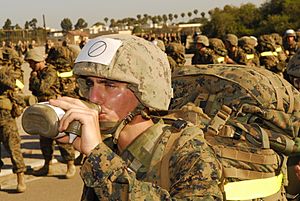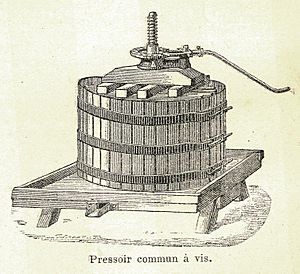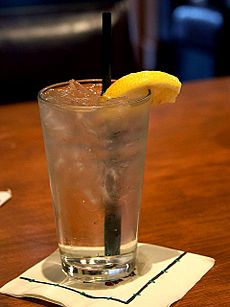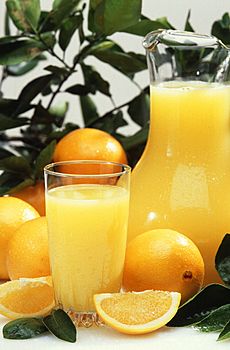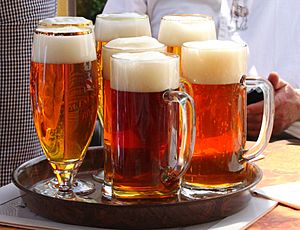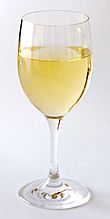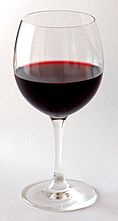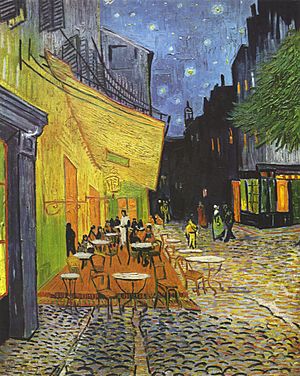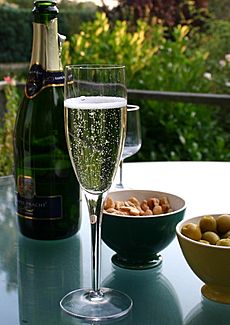Drink facts for kids
A drink or beverage is a liquid you can take into your body through your mouth. Common drinks for people include water, tea, milk, coffee, juice, and soft drinks. Most drinks are mainly water. All life needs water to survive. Plants get water through their roots, which are underground. Most animals get water by drinking. To drink means to take a liquid into your body.
Contents
Why We Need Drinks
When your body doesn't have enough water, you feel thirst. This feeling makes you want to drink. Your brain, specifically the hypothalamus, controls thirst. It reacts to small changes in your body's electrolytes (important salts) and how much blood is flowing. Not drinking any water will cause death faster than not having any other substance. Water and milk have been basic drinks throughout history. Water is vital for life, but it has also carried many diseases in the past.
As humans developed, new ways were found to make drinks from plants. The oldest proof of wine making is from Georgia (around 6000 BCE) and Iran (around 5000 BCE). Beer might have been known in Neolithic Europe as early as 3000 BCE. It was mostly made at home. Some people believe that making beer (and bread) helped humans develop technology and build civilizations. Tea probably started in Yunnan, China, during the Shang Dynasty (1500 BCE–1046 BCE) as a medicine.
Drinks Through History
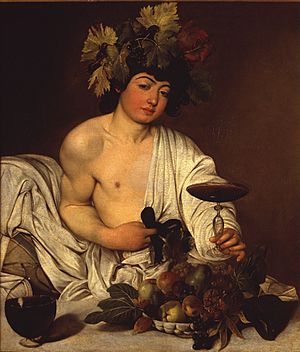
Drinking has always been a big part of social gatherings. In Ancient Greece, a social event for drinking was called a symposium. People drank wine mixed with water. These gatherings could be for serious talks or just for fun. In Ancient Rome, a similar event called a convivium happened often.
Many early societies thought alcohol was a gift from the gods. This led to gods like Dionysus. Other religions forbid or limit drinking alcohol for different reasons. In some places with a main religion, making, selling, and drinking alcohol is not allowed for anyone.
Toasting is a way to honor someone or wish them well by taking a drink. Another tradition is the loving cup. At weddings or celebrations, a group shares a drink from a large cup until it's empty.
In East Africa and Yemen, coffee was used in religious ceremonies. Because these ceremonies didn't fit with Christian beliefs, the Ethiopian Church banned coffee for everyday use until Emperor Menelik II's rule. Coffee was also banned in the Ottoman Empire in the 1600s for political reasons. It was linked to rebellious groups in Europe.
How Drinks Are Made
A drink is a liquid made for people to consume. This can involve many steps, some before it's moved, and some right before you drink it.
Making Water Clean
Water purification is very important. Water is the main part of all drinks. It's the main ingredient in most. Water is cleaned before we drink it. Ways to clean water include filtering and adding chemicals like chlorine. The World Health Organization says that clean water is super important. They point out that 94% of deaths from diarrhea could be stopped by better water quality. Diarrhea is the third biggest cause of death from infection worldwide.
Pasteurization
Pasteurisation is a process where a liquid is heated for a short time at a certain temperature, then quickly cooled. This process slows down the growth of tiny living things (micro-organisms) in the liquid. This makes the drink last longer before it spoils. It is mostly used for milk. Before pasteurization, milk often had harmful bacteria that could make people sick.
Juicing Fruits and Vegetables
Extracting juice from fruits and vegetables can be done in different ways. Simply crushing most fruits will give a lot of liquid. More pressure can be used to get the most juice out. Crushing and pressing are both used to make wine.
Infusion
Infusion is when flavors are taken from plant material by letting it sit in water. This is how teas and herbal teas are made. It can also be used to make coffee if you use a coffee press.
Percolation
Percolation means to make a liquid pass through a substance to get something out of it. For making coffee, water passes through coffee grounds. This takes out the chemicals that give coffee its color, taste, smell, and energy-boosting effects.
Carbonation
Carbonation is the process of dissolving carbon dioxide gas into a liquid, like water. This is what makes fizzy drinks bubbly.
Fermentation
Fermentation is a natural process that turns sugar into ethanol (alcohol). Humans have used fermentation to make drinks since the Stone Age. In winemaking, grape juice is mixed with yeast in a special environment without air. The yeast eats the sugar and makes alcohol. How much sugar is in the wine and how long it ferments decide how much alcohol and how sweet the wine will be.
When brewing beer, there are four main ingredients: water, grain, yeast, and hops. The grain is made to sprout by soaking and drying it with heat. This is called malting. Then it's ground and soaked again to make sugars for fermentation. This step is called mashing. Hops are added for flavor. Then yeast is added to the mixture (called wort) to start fermentation.
Distillation
Distillation is a way to separate mixtures based on how easily their parts turn into vapor when boiled. It's used to clean water. It's also used to make strong alcoholic drinks (spirits) from milder ones.
Mixing Drinks
An alcoholic mixed drink with two or more ingredients is called a cocktail. Originally, cocktails were a mix of spirits, sugar, water, and bitters. Now, the word is used for almost any mixed drink with alcohol. A cocktail usually has one or more types of alcohol and one or more mixers, like soda or fruit juice. Other ingredients can be sugar, honey, milk, cream, and different herbs.
Kinds of Drinks
Non-Alcoholic Drinks
A non-alcoholic drink has very little or no alcohol. This includes low-alcohol beer, non-alcoholic wine, and apple cider if they have less than 0.5% alcohol. The term "soft drink" means it has no alcohol, unlike "hard drink." Drinks like soda pop, sparkling water, iced tea, lemonade, root beer, fruit punch, milk, hot chocolate, tea, coffee, milkshakes, and tap water are all soft drinks.
Water
Water is the most consumed drink in the world. However, 97% of Earth's water is salty and not drinkable. Fresh water is found in rivers, lakes, underground, and in glaciers. Less than 1% of Earth's fresh water is easy to get from surface and underground sources.
In Western countries, water is often drunk cold. In Chinese culture, it is usually drunk hot.
Milk
Milk is seen as one of the "original" drinks. It's the main food for babies. In many cultures, especially in the Western world, people continue to drink milk after infancy. They use milk from other animals like cattle, goats, and sheep. Plant milk, which comes from plants, has also been drunk for a long time. Popular plant milks are soy milk, almond milk, rice milk, and coconut milk.
Tea
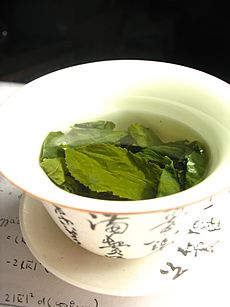
Tea is the second most consumed drink globally. It's made by soaking dried leaves of the camellia sinensis plant in boiling water. There are many ways to prepare tea. Lemon or milk and sugar are common additions worldwide. Tea is also served differently in different countries. In China and Japan, tiny cups are used. In Thailand and the United States, tea is often served cold (as "iced tea") or with lots of sweetener. Indians boil tea with milk and spices to make masala chai.
Tea leaves can be processed in different ways, which changes how the drink looks and tastes. Chinese yellow and green tea are steamed, roasted, and dried. Oolong tea is partly fermented. Black teas are fully fermented.
Around the world, people call other herbal infusions "teas." These were popular long before the Camellia sinensis plant was used for tea. Leaves, flowers, roots, or bark can be used to make a herbal infusion. They can be bought fresh, dried, or as powder.
Coffee
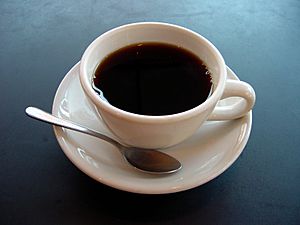
Coffee is a brewed drink made from the roasted seeds of an evergreen plant called Coffea. The two most common types of coffee beans are Coffea arabica and Coffea canephora. Coffee plants grow in over 70 countries. Once the coffee "berries" are ripe, they are picked, processed, and dried to get the seeds inside. The seeds are then roasted to different levels, depending on the flavor wanted. After roasting, they are ground and brewed to make coffee.
Coffee is slightly acidic (pH 5.0–5.1). It can make people feel more awake because of its caffeine. It is one of the most popular drinks in the world. It can be made and served in many ways. Many studies have looked at how coffee affects health, but the results have varied.
Coffee growing first happened in southern Arabia. The earliest proof of coffee drinking is from the mid-1400s in Sufi shrines in Yemen.
Carbonated Drinks
Carbonated drinks have carbon dioxide dissolved in them. This can happen naturally, like in some natural water springs, or artificially by adding carbon dioxide under pressure. The first artificially carbonated drink sold was likely made by Thomas Henry in the late 1770s.
Cola, orange, ginger, and lemon/lime are common flavors for non-alcoholic carbonated drinks. Sugars and preservatives might be added later. The most popular carbonated soft drinks are made by three big global brands: Coca-Cola, PepsiCo, and the Dr Pepper Snapple Group.
Juice and Juice Drinks
Fruit juice is a natural product with few or no added ingredients. Citrus juices like orange juice and tangerine juice are common breakfast drinks. Grapefruit juice, pineapple, apple, grape, lime, and lemon juice are also popular. Coconut water is a very healthy and refreshing juice. Many kinds of berries are crushed, and their juices are mixed with water and sometimes sweetened. Raspberry, blackberry, and currant juices are popular. Grape juice that is allowed to ferment makes wine.
Fruits spoil quickly, so being able to get and store their juices was very valuable. Some fruits are very acidic, so mixing them with water and sugars or honey was often needed to make them taste good. Early ways of storing fruit juices were a lot of work. They involved crushing fruits and mixing the pure juices with sugars before bottling.
Vegetable juices are usually served warm or cold. Different vegetables can be used, like carrots, tomatoes, cucumbers, and celery. Some vegetable juices are mixed with fruit juice to make them taste better. Many popular vegetable juices, especially those with a lot of tomato, are high in sodium. So, drinking them for health needs to be thought about carefully. Some vegetable juices offer the same health benefits as whole vegetables, like lowering the risk of cardiovascular disease and cancer.
Alcoholic Drinks
A drink is "alcoholic" if it contains ethanol, commonly called alcohol. Beer has been part of human culture for 8,000 years. It is the third most popular drink overall, after water and tea. Some believe it is the oldest fermented drink.
Some of the earliest writings mention making and selling beer. The Code of Hammurabi had laws about beer and beer shops. Today, the brewing industry is a global business. It includes big international companies and thousands of smaller makers.
Cider is a fermented alcoholic drink made from fruit juice. Most commonly, it's made from apple juice, but also from peaches, pears ("Perry" cider), or other fruits. Cider can be made from any apple type. However, certain types grown only for cider are called cider apples. The United Kingdom drinks the most cider per person. It also has the largest cider-making companies in the world. As of 2006, the U.K. made 600 million liters of cider each year.
Wine is an alcoholic drink made from fermented grapes or other fruits. Grapes have a natural balance that lets them ferment without adding sugars, acids, or other things. Yeast eats the sugars in the grapes and turns them into alcohol and carbon dioxide. Different types of grapes and yeasts make different kinds of wine. The final wine can have thousands of chemical compounds.
Wines made from things other than grapes are usually named after what they are made from. Examples are rice wine, pomegranate wine, apple wine, and elderberry wine. These are generally called fruit wine. The word "wine" can also mean drinks made from fermented starch or stronger alcoholic drinks, like barley wine or sake.
Wine has a long history, going back thousands of years. The earliest wine making found was around 6000 BCE in Georgia. It reached the Balkans by about 4500 BCE. It was drunk and celebrated in ancient Greece and Rome.
From its first mentions in writing, wine has also been important in religion.
The term "spirit" means a distilled drink that has no added sugar and at least 20% alcohol by volume (ABV). Popular spirits include brandy, gin, rum, tequila, vodka, and whisky. Brandy is made by distilling wine. Vodka can be made from any plant material rich in starch or sugar. Most vodka today is made from grains like sorghum, corn, rye, or wheat.
Drinks in Culture
Places to Drink
Throughout history, people have gathered in places to socialize while drinking. This includes cafés and coffeehouses, which mainly offer hot drinks and light snacks. Many coffee houses in the Middle East and in West Asian areas in the Western world offer shisha (flavored tobacco smoked through a hookah). Espresso bars, like Starbucks, specialize in serving espresso and espresso-based drinks.
In China and Japan, people would socialize and drink tea in a tea house. Chinese scholars used teahouses to share ideas.
Alcoholic drinks are served in drinking establishments, which have different cultural meanings. For example, pubs are very important to the culture of Britain, Ireland, and Australia. In many places, especially in villages, a pub can be the main meeting point for the community.
Pairing with Food
Food and drink are often paired together to make the taste experience better. This mostly happens with wine, and a whole culture has grown around it. The weight, flavors, and textures of food and drink can either be contrasted or made to go well together. Lately, food magazines suggest specific wines with recipes. Restaurants also offer meals with different courses, each matched with a special wine.
Images for kids
-
Whiskey served "on the rocks"
See also
 In Spanish: Bebida para niños
In Spanish: Bebida para niños


